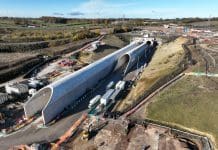To build homes faster there must be a focus on overcoming infrastructure challenges, says Natalie Elphicke, Chief Executive, The Housing & Finance Institute
Recent government statements, papers, articles and reports about the housebuilding industry mostly ignore the housebuilding recovery that has happened since the financial crisis of 2008. Too few look practically at how to help get more housebuilding undertaken on the ground. Papers and articles rarely roll up their sleeves to identify the things needed to help to build more homes faster.
The work we undertake at the Housing & Finance Institute is an exception to that general rule. For a start, we independently consider the state of the housing and finance markets and therefore recognise the recovery that has taken place. Secondly, we work actively and positively with industry, as well as local and national government to identify and unblock action to support housing activity across the country.
The Housing Infrastructure Pilot
The Housing Infrastructure Pilot work is one of the ways we are doing this. Industry discussions early last year identified that housebuilding in some areas was slowed down where utilities were not provided in a reasonable time or at a reasonable cost. Water and sewerage were identified as particular problems. In some cases, sites were stalled indefinitely, especially where the costs being asked for were prohibitive. In other cases, housebuilding was slowed for several months, multiplying costs for site delivery.
We undertook detailed research and data analysis to look at the issue. The further research and data analysis showed there was a problem. This problem seemed particularly acute in parts of the South East and was broader than just utilities. Roads, together with environmental costs and requirements, such as bat hotels and newt surveys, were also identified as constraints on housing delivery. Re-housing species was taking precedence over housing people.
Research project
Following on from that research work, the Housing & Finance Institute designed and launched a project in Essex, Kent and East Sussex, supported by the South East Local Enterprise Partnership and the Home Builders Federation. We have put together an expert steering group from the county and national experts, covering construction, development, utilities, roads and the Department for Communities and Local Government. The work reports to the Housing & Planning Minister shortly.
What has the pilot found? It has confirmed cases where infrastructure is holding back housebuilding. In some instances, where a technical resolution could not be found or at a reasonable cost, some homes were lost for good.
The detailed discussions with developers around the pilot area showed consistency of poor outcomes for new homes. While these problems were not confined to smaller sites, the willingness for district, county and national authorities to engage and resolve the challenges, including through additional funding, was predominately focussed on larger sites. In the pilot area, the majority of homes are provided through smaller sites and a range of regional and local builders. This means that a large strategic sites focus was not appropriate in terms of allocating time and funds to get homes built faster.
A key finding from the pilot is that basic business practices are not being followed for the construction and development industry. This includes information about who to contact, single points of contact and timely provision of costs.
There has been some good news too. There is an unequivocal willingness to understand the adverse impact and up the game of the infrastructure providers. Engagement from the main infrastructure providers who are developing best practice, such as Anglian Water, has been excellent. Other providers such as OpenReach have presented their plans for improving broadband delivery to mid to larger sites. There have been highlights of emerging better practice in communications and single points of contact. While not without technical complications, multi-utilities provision offers an opportunity for further improvements in cost-effective and better infrastructure delivery. The pilot has been greatly assisted by the technical expertise of engineers from the Home Builders Federation and data and analytics provided by the National House Building Council.
We have undertaken technical prioritisation and impact work to try to unpick how much of infrastructure cost identified in local government work relates to building homes, rather than everything else. The application of a split between ‘housing delivery required’ and ‘sustainability required’ infrastructure has been tested in areas across the pilot area and is helping to better identify where the needs and priorities are within an area.
To put that simply, one type of area might have expensive historical upgrading to water requirements or no sewerage facilities, without which the housebuilder cannot build. Another type of area with excellent core utilities infrastructure may instead require large education or health contributions. In the first type of area, that is a housing delivery essential infrastructure. It needs to go in for any new homes to be built. The second type of area tends to be larger established growth areas. It isn’t unheard of for large contributions to education or health to be collected but unspent or unallocated while schools are planned or health provision re-organised when in the first type of area there is gap funding required to get anything done. Better distribution of infrastructure contributions would help ensure a broader base of strong and sustainable communities.
The Homes & Communities Agency have been a strong part of the pilot work. They do have advanced infrastructure funding available to lend to support housebuilding through their HCA Invest arm, as well as accelerated construction and other programmes. The new National Infrastructure Fund includes housing within its remit, although currently it is not expected to be focused on the first type of area, continuing the larger strategic focus.
There has been strong progress made in the last few years on housebuilding. More homes are being built. There is a climate of housing ambition and a focus on performance, which is providing homes on the ground. 2016 was the fourth highest year for housing growth in the last 25 years. Housing completions performance has powered past the long-term trends after the recession; housing starts are increasing, and the stock of planning permissions receiving approval is at record levels.
Yet there are signs of caution in some parts of the industry. To power on there is a need to build out the planning permissions and to build more homes faster – to build out homes in all types of areas where there is a need and available opportunity. The work of this housing infrastructure pilot will support that aim and ambition. If we are to build more homes faster, we need to deliver infrastructure better and faster too.
 Natalie Elphicke
Natalie Elphicke
Chief Executive
The Housing & Finance Institute
Connect@thehfi.com









![[VIDEO] Cambridge waste water plant granted permission to relocate Artist impression of the new Cambridge waste water plant and surrounding land](https://www.pbctoday.co.uk/news/wp-content/uploads/2025/04/p.151-768x364-1-218x150.jpg)



